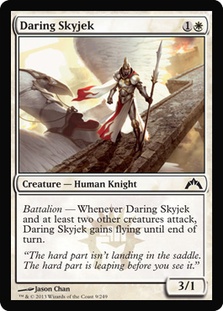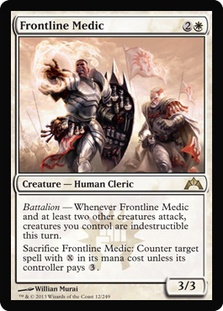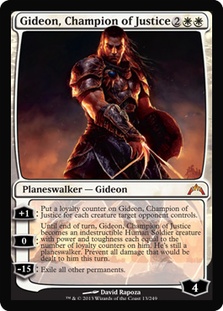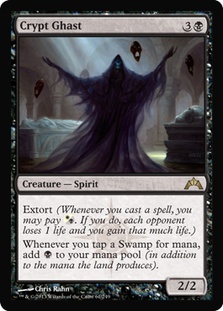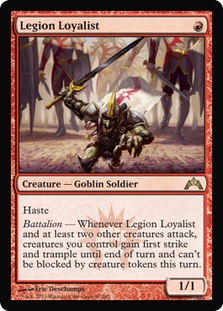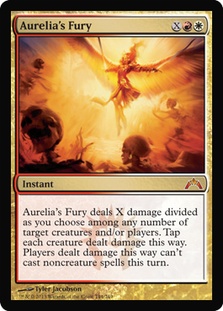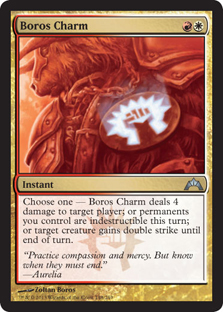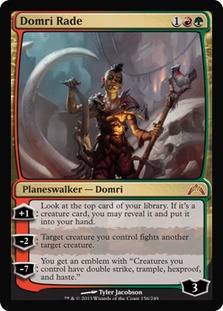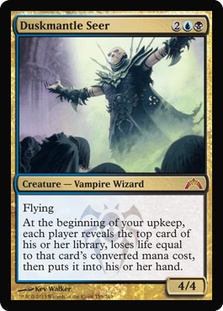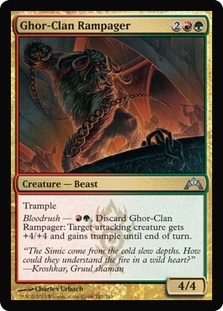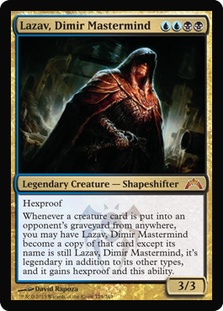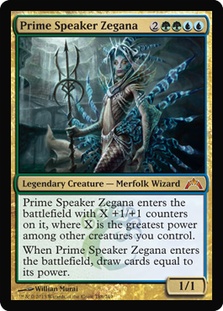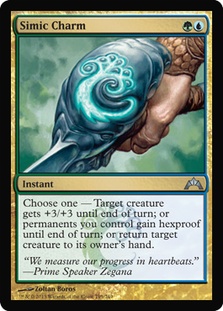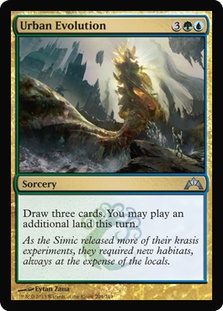Most cube designers expected Gatecrash to impact their lists in the same way Return to Ravnica did. After all, it’s larger than most second sets, and I don’t think it was presumptuous to assume Wizards would be unveiling some sick tech from the unspoiled guilds. Unfortunately, I know I’m not the only one that has done a double and triple take at the spoiler, only to find that the list of additions is…well…short.
I think any person’s disappointment in this set is probably because their expectations were too high. In my last Cube article, I explored the impact that the entire block would have on cube multicolor design and organization. It was my hope that Gatecrash would help balance the multicolor cards that were added from RTR and usher in a new era of cube design that would increase the size of our multicolor sections.
My expectations for Gatecrash were decidedly unreasonable. I expected them to fix everything wrong with the Simic, Boros, and Orzhov guilds in my list. For every Supreme Verdict and Deathrite Shaman we got in Return to Ravnica, I expected an equal in Gatecrash. The truth of the matter is that this isn’t a good way for Wizards to design sets. If this formula worked, we’d have 100 Ravnica clones by now.
The fact is that we were probably more than a little spoiled by Return to Ravnica, as well as the last few blocks. We shouldn’t expect even larger sets to give us dozens of cube-able cards. Mechanics are really what drive whether a set’s cards are cube-able, not the number of new cards we see. Of course mechanics like “can’t be countered” and miracle are going to be better than linear mechanics like dredge, infect, affinity, splice, and tribal. The mechanics in Gatecrash just aren’t the best mechanics for cubes. They either require a critical mass of those effects to be good or are just not cost efficient enough to see play. All that said, I think this set is much better for cube design than most small sets we’ve had in the past, so I wouldn’t call this one a failure by a long shot.
This time around, I decided to try a different spin on the way I traditionally do set reviews. Rather than looking in depth at the mechanics and giving a number of cards a play, pass, or fail rating, I am simply going to discuss which cards are 100% going to make the cut in my list. There are a number of cards that I haven’t had the opportunity to test, so in many cases I’ll only be theorycrafting, but most of the cards in this list were proxied and sleeved up the day they were posted in the spoiler. For those of you interested, I tested around 30 cards from this set with my weekly group.
For this review I will post the card, my evaluation of what the card does, what decks it’s good in, etc., and a few cards I would suggest cutting to make room in your list. Keep in mind that my list is around 600 cards. In smaller lists, it’s going to be slightly more difficult to find room for some of the more vanilla cards. Obviously, every list is going to have different criteria for what makes a card a good addition. If you have any questions about what you should cut from your list to make room for something I’ve talked about, please feel free to leave it in the comments.
Daring Skyjek
For years I ran Blade of the Sixth Pride in my list as an efficient and splashable beater. When the strictly better Accorder Paladin was printed, it was an easy swap, and the Cat hit the bench. Initially, I didn’t think I wanted another Blade clone, but I’ve since changed my opinion. Lately I’ve been trying to phase out all the double-white creatures in my cube. They’re difficult to cast outside of a white-heavy aggro deck, and they don’t tend to get incidentally picked over other splashable cards. For example, if my first pick is Lightning Bolt or Doom Blade, I think most players would be likely pick something like Accorder Paladin or Stormfront Pegasus over Knight of Meadowgrain or Eight-and-a-Half Tails.
Skyjek reminds me a lot of the other evasive two-drops in white. I like that before your opponent can put blockers on the ground he gets in for three. Once you’ve developed your board presence, he charges up and can help seal the game. Pound-for-pound, I think this is one of the better two-drops white has had in recent memory.
Suggested Cuts: Pump Knights, subpar WW creatures, Jotun Grunt, Blade of the Sixth Pride, Kor Skyfisher, Lone Missionary
Frontline Medic
The three-drop slot in white is full of cards that you want to curve into but very few cards that actually provide a reasonable board presence on their own. Frontline Medic is a nice medium between the two. It’s exactly the kind of card you want to follow-up with after you’ve gone one-drop, two-drop. If your opponent doesn’t deal with it, you can essentially ignore their side of the table altogether, which is white’s MO.
Compared to other three-drops in white, I think it is probably on the same power level as something like Soltari Champion. It doesn’t pump attackers like the Champion does, but it has respectable stats. Being a 3/3 for three mana with no prerequisites is what puts it over the top for me. No other creatures in this range have the kind of stats the Medic has. As for the X ability, I believe this card is plenty good enough without it. It may not come up often, but stopping your opponent from Earthquaking or Bonfiring your side of the board away is something that nontoken white builds have a hard time coming back from.
Suggested Cuts: Fiend Hunter, Mystic Crusader, Paladin En-Vec, Pianna, Nomad Captain
Gideon, Champion of Justice
Much like the reception of Gatecrash, the newly minted Gideon is being measured based on his other planeswalker brethren. I’ve heard a number of different evaluations for this card, ranging from completely unplayable to insane. The thing about all planeswalkers (even the seemingly awful ones) is that you simply cannot evaluate them based on how good you think they will be. I think back to when I saw the newly spoiled Elspeth, Knight-Errant and thought that it was just okay. I may have been a little wrong about that one.
It’s easy to look at something like burn or a Doom Blade effect and deem it unworthy because it’s too narrow or overcosted. Planeswalkers are much more difficult to evaluate because their effect on the game at hand is so much grander than something like a creature, equipment, or removal spell. There are very few cards that can quite literally end the game by themselves.
I’ve been testing Gideon for a few weeks just so I can wrap my brain around what kinds of decks Gideon is good in. Hell, I’ve been trying just to wrap my brain around what exactly Gideon does. Though my testing is not exhaustive by any means, I am convinced he is much better than he appears on the surface. Gideon is surprisingly good at playing both the aggro and control roles.
In aggro, he takes up the four slot. This slot is not typically known for its aggressive creatures. I think part of this is because white wants to be refueling the board after having guys picked off or casting Armageddon to seal the game. Gideon presents an interesting conundrum for your opponent if you’re playing a White Weenie deck. Do I allow my opponent to untap and attack me for 5+, or do I attack into Gideon and leave myself open to the other attackers next turn? In this role, I look at Gideon as a blend of Calciderm and Chimeric Idol. He’s very difficult to deal with in both cases and isn’t Wrathable.
Wearing the control hat, Gideon plays out very differently. It’s not unrealistic to get Gideon to 15+. You’d be surprised how easy it is to pump him in just a few activations. The trick is to have something to back it up like Wrath effects or Maze of Ith. Just ultimating him isn’t going to win you the game the same way Karn Liberated does, but it’s more like a delayed Upheaval. If you have him on fifteen, you can float mana, exile the world, then replay any artifact mana and hit your land for the turn. Like all planeswalkers, he forces your opponent to play Magic differently. This lets you blow them out with cards like Restoration Angel or a well-timed Wrath. Gideon is exactly the kind of card that I want in my cube. He’s interesting, skill testing, and very rewarding.
Suggested Cuts: Calciderm, Cataclysm, Kor Sanctifiers, Moat, Angel of Jubilation
Crypt Ghast
Part of why I like Gatecrash as a set isn’t necessarily because I am enamored at the power level, flavor, or mechanics, but rather because of the cards that are in casting costs that are otherwise pretty weak. For this reason, some cards stand out when they might not otherwise be as good in another color or casting cost.
Crypt Ghast is a great example of this. Black has historically run some pretty bad cards in the four slot. Do you remember how long it took for people to finally cut Juzam Djinn? I know part of it was to open a pack and see the sinister Djinn staring back at you saying, “Draft me or you’ll be just like this 0-4 drafter I’m about to eat.” Eventually, we got enough replacement cards at that slot that we no longer needed to run the Djinn and Clones like Plague Sliver or Sewer Nemesis anymore. That, however, doesn’t mean it’s the most competitive slot in black.
Crypt Ghast has the potential to end the game with just a little support and planning. In a deck dedicated to abusing the Mana Flare effect, Ghast can generate huge amounts of mana for very little investment. Ideally, you want to run this alongside support cards like Urborg and other Swamps matters cards, and it helps to have ready access to Reanimation in case your plan goes awry. Even in a deck that isn’t solely dedicated to naturally casting turn 4-5 Griselbrands, Ghast helps play big spells and ensures you have mana up to support them. In my experience playing it so far, it’s been a welcome addition to the black arsenal. While it’s a little more fragile than other Flare effects, the fact that it’s one-sided sells it for me. The extort is just gravy.
Suggested Cuts: Abyssal Persecutor, The Abyss, Juzam Djinn, Sewer Nemesis, Liliana Vess
Legion Loyalist
If you know me, you know that I’ve recently started pushing a small Goblins subtheme in red. Understand that my inclusion of this card in my list of additions isn’t because of the extra Goblins support. Worst-case scenario for this guy is you’ve got a Raging Goblin. It’s worth mentioning that most lists I’ve played with have never had a one-mana haste creature. The value you can get by playing this guy on a board with just a Sword or Jitte can be devastating; however, I don’t believe this is the best use for Loyalist. I see Loyalist as a support spell. Red typically has a problem forcing damage through chump blockers. Often, red can lose a game just a few points shy of victory because an opponent hit their fourth land for a Wrath or fifth land for a Thragtusk.
Loyalist plays out best when you have some reasonable attackers (two-four-drops) on the board and a need to sneak in that extra damage. The first strike means very few creatures are going to trade in combat, and the trample helps creatures like Keldon Champion and Flametongue Kavu do some serious damage. I think he gets even better when paired with white and green, which can play larger creatures earlier. I push tokens fairly heavily, so I expect the token clause to come up pretty often. All these together make for an extremely rounded 1/1 fit for cubes of all sizes.
Suggested Cuts: Goblin Patrol, Spikeshot Elder, Magus of the Scroll, Reckless Charge, Genju of the Spires
Experiment One
A year or two ago, I discovered that players just didn’t like drafting green-based aggro. After this realization, I began cutting the unexceptional green aggro creatures like Pouncing Jaguar, Troll Ascetic, and Jungle Lion. I’ve had countless discussions on the subject, but the bottom line is that I believe green is much better suited to ramp and playing bigger creatures than trying to seal the early game. Experiment One stays true to its name in that it’s an experiment to see if it is flexible enough to survive in a non-dedicated aggro deck.
I consistently found Experiment One growing to three power without having to spend additional mana or resources. In a lot of ways, he has been playing out like Wild Nacatl. Nacatl is one of the few green one-drops left in my cube that doesn’t make mana. It’s obviously best in a dedicated Naya deck but is perfectly serviceable in G/W or R/G. You might only pump Experiment One once or twice, but I’ve seen it exceed Nacatl stats several times in its short time in my list. The regeneration clause makes it about as annoying as something like Strangleroot Geist and thus very good with equipment and Anthem effects. For the mere cost of one green mana, I think this card is a steal and might help put green-based aggro back on the map.
Suggested Cuts: Jungle Lion, Wild Dogs, Pouncing Jaguar, Elves of Deep Shadow, Albino Troll
Note: The next cards in the list are all multicolor and hybrid cards. There are far fewer options to cut than in other sections. For example, a typical white section might include 40-80 cards, but a multicolor pair might only have three to five cards. For this reason, I will only include a couple cut suggestions per card. If you want additional ways to fit these cards, I wrote an article a few months ago about hybrid reclassification as a way to make room for new multicolor cards.
Aurelia’s Fury
Rolling Thunder has long been a staple in Pauper and Peasant cubes, but it has never quite been good enough for mainstream cube use. Earthquake, Bonfire of the Damned, Rolling Earthquake, Banefire, and Devil’s Play are the last bastion of playable X spells. Every block gives us a crack at a new X spell, but they rarely last more than a few drafts. They’re just not that exciting to draft anymore. Aurelia’s Fury seeks to break that mold. At its most basic level, Fury is an instant speed Rolling Thunder. That alone is likely not grounds for inclusion, but it’s been given a couple abilities that take it from good to backbreaking.
The tap ability is very versatile. In a control deck, you can ping off a few dorks left over from the early game and tap down your opponent’s biggest threats to buy you time to Wrath and take back control of the game. The same tap ability gives aggressive decks the extra push they need to force those last few points of damage through. If Bonfire has been good enough for these decks, then Fury should be similarly excellent. Casting Fury even for X=1-2 at the end of your opponent’s turn can help you to spend your mana on haste creatures or equipment. In a pinch, it can act as a small Orim’s Chant to help force through big spells like Titans or planeswalkers in ramp decks. Fury is incredibly flexible, powerful, and will no doubt inch its way up the white-red multicolor food chain.
Suggested Cuts: Slayer’s Stronghold, Duergar Hedge-Mage, Goblin Trenches
Boros Charm
We’ve gotten a lot of Charms over the last twenty years of Magic, but not until Boros Charm have we been in the presence of perfection. All three modes blend together in perfect harmony to bring red-white decks one of the most powerful spells they’ve been given since Ajani Vengeant. If you want an idea of how powerful this card is, I think it’s on-par if not better than Lightning Helix.
Let’s take a look at all three modes of Boros Charm to understand how and why this card is so powerful. The damage ability is far and away the most efficient instant speed burn ever printed. The closest red has had to this ability was Flame Rift at 1R and at sorcery speed. While this alone isn’t quite good enough for cubes, this is a fantastic mode for red’s arsenal. Red will always be happy to play additional burn, especially at two mana.
The indestructible mode is a blowout spell of epic proportions. It stops Wraths, ‘Geddons, Earthquakes, spot removal, and combat damage. Oh, and it’s got a fourth mode of stopping all of those same spells when you’re on the end of them. If you haven’t cast Armageddon when your permanents are indestructible, you haven’t lived.
The Double-Cleave ability is gravy on top of gravy on top of gravy. If you have this card in your hand, you can suck every last ounce of value out of the board state and put yourself in a winning position for the mere cost of two mana.
Suggested Cuts: Goblin Legionnaire, Brion Stoutarm
Domri Rade
Every three-mana planeswalker printed to date has been a great addition to cubes of all shapes and sizes. This is the first three-mana ‘walker green has been given, and I think that’s pretty important. I’ve been maximizing one-mana Elves over the last few years after realizing that green-based aggro was never better than ramping into bigger and better creatures. I can’t imagine many better scenarios for a R/G creature deck than slamming Domri on turn 2 or 3.
All of Domri’s abilities directly involve creatures, so he’s probably best in decks running fourteen or more. The first mode is a fantastic way to help keep pressure on your opponent. Just throw it down early and it’ll be unlikely to leave the board unless your opponent wants to give up blockers. It’s interesting that the card sticks around the top of your deck. This means that your late fetchlands can help you to fix your draw. Library manipulation like Top or Ponder is obviously very good but is less likely to see play next to Domri given that you’ll want a critical mass of creatures.
The second ability is a little expensive but is great at protecting your board and keeping Domri around. It can singlehandedly win you the creature deck on creature deck matchup the way that creature-based planeswalkers like Ajani Goldmane and Ajani, Caller of the Pride can. The last ability can take a while to build to, but like most ultimates, it should help you to seal the game. I was excited when this card was spoiled, and I haven’t been disappointed. Between Domri Rade and Ghor-Clan Rampager, R/G aggro has received a whole new set of goodies.
Suggested Cuts: Sarkhan Vol, Stormbind
Duskmantle Seer
I can’t look at Duskmantle Seer without smiling a bit. It’s exactly the kind of card that I open P1P1 and immediately craft my deck around it. At Moroii’s stats, Duskmantle Seer is no slouch. At home in tempo decks and decks that have a ton of library manipulation, Seer generates card advantage and drains your opponent in one fell swoop. This is exactly the kind of card U/B tempo wants to be playing. You’re likely controlling the game with tempo counters, Wastelands, and small creatures while slowly pinging your opponent, and when you hit four to six mana, the Seer comes down and seals the deal.
The only ding for Seer is that in the same situations Dark Confidant is bad it can be bad as well. If your deck is full of cards like Grave Titan and Upheaval, it’s going to get worse. This certainly hasn’t stopped me from playing Bob in my control decks, even when the average converted mana cost of my spells is approximately nine.
The fact is that in these colors you have the most tools to take full advantage of the card drawing effect while minimizing the damage through library manipulation and you’re least likely to be affected by your opponent drawing additional cards. Black is very good at playing the resource denial game, and it has a full arsenal of spells at one and two mana that can deal with permanents of all shapes and sizes. Another boon for Seer is that there are very few cards that outright kill it in combat and most non-bounce non-Swords removal spells don’t turn off the second ability. He’s a well-oiled machine that has quickly stolen my heart and should be right at home in your list.
Suggested Cuts: Psychatog, Oona, Queen of the Fae
Ghor-Clan Rampager
I’ll be honest. I originally skipped over this guy when he was first spoiled. Then I skipped over him again a week later when printing proxies for testing. I did this several more times before someone finally asked why I wasn’t including him. I couldn’t think of a good reason. I guess I just wasn’t keen to try out bloodrush. Sometimes cards with tricky mechanics aren’t discovered until after a few weeks of drafting with the latest set. I have quickly come around to Rampager after seeing its power demonstrated in a couple drafts. Abilities like bloodrush, channel, cycling (with an ability), and kicker turn otherwise regular cards into split cards. When you look at Ghor-Clan Rampager as either a 4/4 trampler for four mana or an uncounterable Colossal Might, then it starts to look much more attractive.
Through the years, I’ve been quick to cut cards like Rumbling Slum and Spearbreaker Behemoth due to lack of evasion and the ability to actually connect to the dome. Rampager is one of the first R/G cards that has trample and doesn’t cost 5+ mana. This makes it a great curve-topper and can set up some really powerful turn 5 plays. Can you imagine this card with a Sword or Jitte? When you’re not bashing, it is one of the better combat tricks Gruul has access to. I’ll be honest; I’m a little worried that Rampager will loop because there isn’t a dedicated R/G aggro deck at the table. I am hopeful that between this guy and Domri Rade that R/G will get a nice boost and give players good reasons to go into creature decks.
Suggested Cuts: Giant Solifuge
Lazav, Dimir Mastermind
When a legendary mythic rare gets printed with hexproof, it would be irresponsible for a cube designer not to take a second look at it. Let’s see what UUBB buys us. For the mere investment of four mana, we get a Hill Giant with hexproof. That’s nothing to write home about, but Lazav can be oh so much more than what you see on the surface.
His second ability triggers whenever a card goes to your opponent’s graveyard from anywhere. From anywhere. And it’s optional. What does this mean for Lazav? Well, it’s obviously quite good in a deck full of Doom Blades and Terminates. If your opponent wants to resolve something like a Baneslayer or Titan, they may have to think twice. The trick is on the table. If you want to play your big guns, be prepared to have them coming right back at you and with hexproof.
It has the secondary ability of essentially shutting off voluntary discard. This means Survival of the Fittest and Forbid are liabilities. With Lazav on the table, your opponent’s combat math had better be good, and they better find a way to get their big guns into play lest your Thoughtseize turn into a virtual Reanimation spell. I like that Lazav changes the entire dynamic of the way your opponent has to play, similar to the way a planeswalker affects the board.
Lazav is a great build-around-me card and should feel right at home in tempo and something like Grixis control. He’s an incredibly fun card and should create some pretty memorable plays. While the mana cost can appear daunting, I don’t think that will deter cubers from picking this guy up after seeing him in action. I highly suggest giving him a shot in your list.
Suggested Cuts: Havengul Lich
Obzedat, Ghost Council
In early iterations of my list, I ran the original Ghost Council of Orzhova, but it was eventually cut for not being good enough. The new Ghost Council is similar in many ways to the original. It’s a vanilla creature with P/T equal to its mana cost, it’s difficult to kill, and it drains your opponent. Why, then, would Obzedat be much better?
This creature is nigh impossible to kill. Aside from cards like Nevinyrral’s Disk, Oblivion Stone, Rout, and target removal, you are going to be hard-pressed to send the Council to the bin. Aside from being a pain in the neck to deal with while it’s on the board, it’s an extremely aggressive attacker. The first time you attack with this, you’ve already drained your opponent for two life. If your opponent doesn’t deal with it that turn, then they’re looking at another two. That’s a potential nine life in just a turn and a half.
I see Obzedat as being very similar to Blastoderm. It’s also a very respectable Reanimation target. What puts it over the top for me is that it has applications in aggressive and slower decks. I believe Obzedat has all the board impact that Angel of Despair has at a fraction of the mana. It’s a must deal with permanent with its own built in protection. If you have room for it, it’s 100% Kranny approved.
Suggested Cuts: Angel of Despair, Desolation Angel, Gerard’s Verdict
Prime-Speaker Zegana
For years two of the most beloved archetypes in my cube have been Blink and Reveillark.dec. There’s just something very fun about taking otherwise okay creatures like Acidic Slime, Man-o’-War, and Avalanche Riders and Blinking them on and off the battlefield a few dozen times. For this reason, I always give creatures with a P/T less than two with an enters the battlefield ability a second look. At worst, Zegana is a six mana 1/1 that draws a card. That’s pretty awful on its own. However, I see the typical scenario for Zegana to enter the battlefield when you have two or three power on the board. Six mana to draw four and get a 4/4 on the board is pretty darn good.
I see Zegana absolutely tearing it up in U/G/X decks with Elves, Blink and cards like Reveillark, Restoration Angel, and nice Reanimation / Natural Order targets like Woodfall Primus and Primeval Titan. Can you imagine casting Tooth and Nail with Zegana and Terastodon as your targets? I think Zegana doesn’t end the game quite like a creature like Simic Sky Swallower, but I feel it’s a great deal more flexible and playable in more decks. It really takes playing a few games with Zegana to understand its true power. It’s an unbelievably tricky card that can take you from having no outs to completely dominating a game like very few cards can at that cost.
Suggested Cuts: Mystic Snake, Simic Sky Swallower
Simic Charm
Much like Boros Charm, Simic Charm is so well rounded that most cube designers aren’t hesitating to add it. I think all three abilities play very well with what U/G decks want to be doing. The pump aligns perfectly with the U/G creature-based tempo decks and is an effect that is drastically underrepresented in most lists. The hexproof ability acts as a virtual Stifle, stopping a number of abilities from Strip Mine effects and planeswalker abilities to targeted removal and Disenchant effects for your equipment or Opposition.
The bounce ability is great for the ramp and tempo decks. It’s cheap enough to help you survive the early game against an aggressive deck as well as provide you a clear path to connect with your army. With all this utility packed into two mana, it’s no wonder that it beats out most of the existing U/G competition.
Suggested Cuts: Snakeform, Voidslime
Urban Evolution
While I think Evolution might be better suited for non-rare lists, I am including it because I feel the Explore / Exploration / Oracle of Mul Daya effect is one of the most underappreciated and underestimated cycles in the cube. With many cube designers choosing to remove a number of artifact mana like Signets and Talismans, green has taken its place back at the top of the ramp food chain. Cards like Exploration help to build a different style of ramp deck that doesn’t rely on creatures to ramp but rather on the power of blue and black to provide card advantage while using Explore effects to dump mass amounts of land on the table.
In the right deck, Urban Evolution is a turn 3 or 4 play. This means on your fifth turn you should have ready access to seven mana. While I don’t think Evolution makes the cut in every list due to capped multicolor sections, I think it’s still a great deal more interesting than other options in U/G and that all cube designers should at least give it a test spin.
Suggested Cuts: Coiling Oracle, Lorescale Coatl
Thanks for taking the time to read this review. While I agree that Gatecrash looks less powerful than other recent releases, it’s definitely not without its hidden gems. As we continue to draft these cards and more sets get released, some of these may hit the bench, but if you’re looking for a change and haven’t given them a shot, make sure you put them in your on-deck binder for a rainy day!
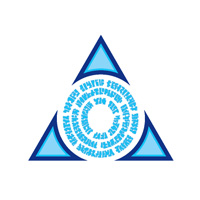 |
In the weeks leading up to banned and restricted announcements, my friends and castmates frequently refer to me as Matt Banstuber. I’ve been known to hone in on cards which seek to threaten the stability and balance of our favorite Constructed formats. Keeping true with this dogma, when a format solves itself and deters creativity, I will seek to remove cards to restore the rule of law. It seems only fitting that my favorite format is cube. I am the sole protector and judge of my realm. I am a member of the Azorius Senate, and I am tasked with the order Ravnica. |

